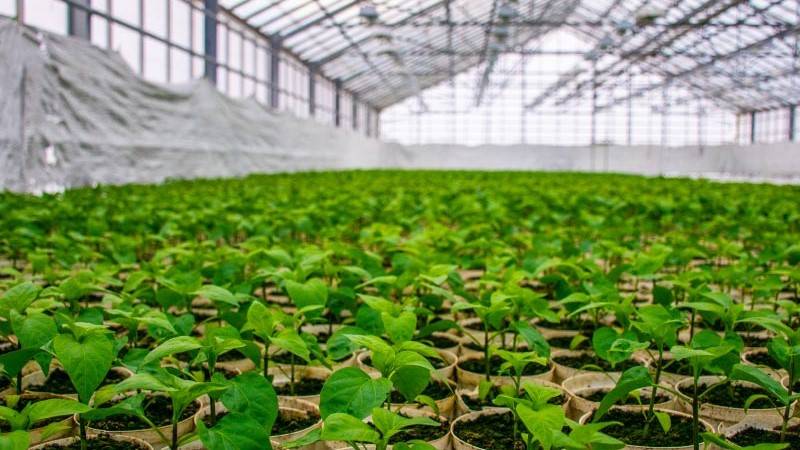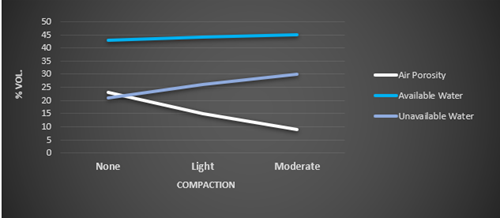Air Porosity: What Is It and How Important Is It?


Most commercially produced growing media are composed of a combination of one or more components, such as sphagnum peat moss, perlite or pumice type materials, coir, bark or wood products, vermiculite and other materials, to produce distinct physical properties that will provide the plant with the best possible air porosity and water holding capacity for greenhouse plant production. In this brief article, we will explore the basics of what air porosity is and why it is important for the production of healthy plants.
What is Air Porosity?
Coarse particles in the growing medium create larger pores that maintain air space and facilitate drainage. Fine particles create smaller pores that help in holding available and unavailable water. The number of large and small pores characterizes the growing medium’s total pore space. The combination of components and their particle size determine the air porosity, total porosity and water holding capacity in a growing medium (Table 1). Total porosity is the measurement of the growing medium’s total volume of these pore spaces. Air porosity refers to the measurement of the volume of pore space in a growing medium occupied by air after it is saturated and allowed to drain. Air porosity is calculated as a percentage of the volume of the growing medium and is inversely related to the bulk density of a growing medium.
| Factors That Influence Air Porosity Growing Media | Influence on Air Porosity |
||
| Decrease | None | Increase | |
| Adding fine components (compost, bark fines) | X | ||
| Adding coarse components (perlite, bark > 3/8″ ) | X | ||
| Adding heavy components (sand) | X | ||
| Excessive fluffing of growing medium | X | ||
| Compaction of growing medium in container | X | ||
| Hand-pressed medium around transplanted plugs/liners | X | ||
| Water with high water pressure | X | ||
| Use shallow containers | X | ||
| Use of deep containers | X | ||
| Use of containers with a large diameter, same depth | X | ||
Most commercially produced growing media have a total pore space of 60 to 80%. The recommended air porosity range for a growing medium varies by crop and the crop production stage: for germination or plug propagation media with fine components, it is recommended to have 10 – 15% air porosity, while for most general greenhouse crop production media with coarser components, it is recommended to have 15 – 25% air porosity, depending on the crop. Table 2 lists the air porosity preferences of several crops.
| Air porosity | |||
| Low 2-5% | Intermediate 5-10% | High 10-20% | Very high > 20% |
| Carnation | Camellia | African violets | Azalea |
| Conifers | Chrysanthemum | Begonia | Orchid |
| Geranium | Gladiolus | Foliage Plants | |
| Ivy | Hydrangea | Gardenia | |
| Palms | Lily | Gloxinia | |
| Rose | Poinsettia | Heath | |
| Stock | Rhododendron | ||
| Turf Grass | Snapdragons | ||
Container height and compaction within the container also play a role in determining the air porosity of the growing medium (Table 1 and Figure 1). Commercially produced growing media are often packaged in a compressed form and the handling of this growing medium at the time of reconstitution and filling the container also impact its air porosity. Overfluffing or processing damages peat fibers, crushes perlite, etc., which creates finer particles that plug up larger pores, reducing air porosity. Therefore, selecting the right growing medium for the crop type and its correct reconstitution is important in maintaining the medium's structure to provide and maintain the required air porosity for plant health and root development (Table 1).

Why Air Porosity is Important in a Growing Medium
Total porosity and air porosity are important for the movement of water and nutrients and for gaseous exchanges within and throughout the root zone. Plant roots need proper air porosity so that the transfer of oxygen and other gases can take place. With the correct air porosity in a growing medium, oxygen can reach all of the cells of the root, where it is utilized in respiration. Carbon dioxide can then be released into the pore space and eventually escape the growing medium through the process of diffusion. If the air porosity of a growing medium is not adequate, insufficient oxygen is available to the roots for respiration. This can adversely affect plant growth rates, the growing medium will dry out more slowly due to less water usage by smaller plants, and plant scheduling can be impacted. In the worst-case scenario, low air porosity can result in poor plant health, which increases plant susceptibility to pathogens and insect attacks, and potential plant losses.
Conclusion
To ensure the best possible crop production, it is important to start by selecting a growing medium with the correct air porosity and water-holding capacity for the crops being grown. It is also vital that a grower use best practices when reconstituting and filling the containers to ensure that the structure and physical properties of the growing medium are maintained. This will help to ensure that the plant roots have the proper porosity for air as well as the proper water and nutrient availability for plant health.